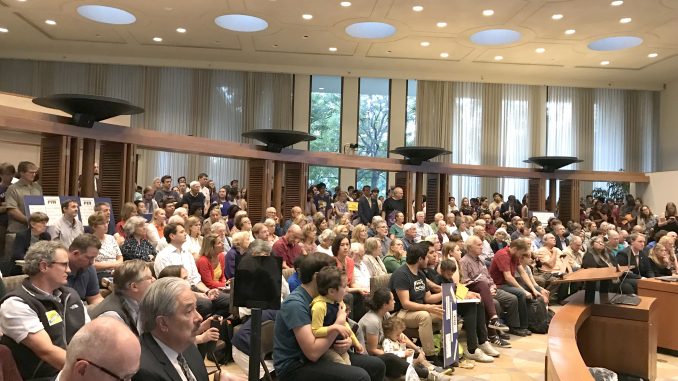
This story originally appeared in Wednesday morning’s Daily Post. Only a fraction of the stories the Post prints appear on this website. To get all the local news, pick up a copy of the Post this morning at 1,000 Mid-Peninsula locations.
BY SARA TABIN
Daily Post Staff Writer
It’s starting to look like Stanford won’t expand after all. Tuesday night Stanford threatened again to walk way from a county development permit they’re seeking if they don’t get exactly what they want from the county.
Local leaders and residents went to the microphone to let the university know that they will be happy if Stanford turns the permit down.
The university is trying to get a permit for a 3.5 million-square-foot expansion over the next 15 years. Stanford has said it only wants the permit if it comes with a development agreement, which would ensure that the county can’t change any of the terms of the permit in the future.
The Board of Supervisors is getting close to approving a permit that would require Stanford to fully mitigate the expansion’s impact on traffic, housing and the school district. Stanford claims that fully mitigating its impact is too hard.
The supervisors came to Palo Alto last night for a hearing about the expansion to give people living close to Stanford the chance to talk. The meeting drew so many people to City Hall that the fire marshal said that some of them had to leave the council chambers and watch the meeting in the lobby, where it was being shown on TV monitors.
Of the 140 speakers, the vast majority were critical of the expansion. Some called on the county to deny Stanford’s application.
“You can always say ‘no’ to the permit,” said Palo Alto Councilwoman Lydia Kou, who said she was concerned about the traffic the development would add.
Other speakers said Stanford should shrink its project.
Former Palo Alto Mayor Peter Drekmeier said that if Stanford finds it infeasible to mitigate its effects on the region, the university’s projects should be downsized or denied.
“If something can’t be mitigated, it needs to be drawn down to something that can be mitigated,” said Former Palo Alto Mayor Karen Holman.
Joe Simitian of Palo Alto, president of the Board of Supervisors, figuratively put Stanford vice president Bob Reidy against a wall when he asked if Stanford will fund local schools if they bring in 1,000 students as part of the expansion.
The county estimates that the Palo Alto Unified School District loses $44.5 million, or $3,727 per pupil, each year because of Stanford’s property tax exemptions. The addition of an estimated 1,086 new students to the district without funding would mean there would be $5,050 less for each student, according to county estimates.
Will Stanford stick to school deal?
Stanford struck a tentative side deal with the Palo Alto Unified School District in April to provide some funding for the new students that will enter the district if the university gets its expansion. The university would give the district $138 million over the life of the GUP, or 30 cents for each dollar it costs to educate a student.
But the side deal was contingent on Stanford getting a development agreement from the county.
Tuesday night, Simitian read aloud a portion of an editorial in the Palo Alto Weekly that said Stanford had promised to honor its commitment to the schools. Simitian asked Reidy whether Stanford is going to stick to the agreement with PAUSD.
Reidy said that the university will only fund the schools if they get a development agreement, which contradicted the editorial. He maintained that the university won’t accept a permit without the development agreement.
Members of the Palo Alto school board and PTAs said they are concerned that new students from Stanford will drain the resources that would be available to other students, and take away money that could be used for mental health resources or to help underperforming students.
Findings of Facts could help schools
When the county board votes on the Stanford plan, which could come as early as next month, it will have to make “Findings of Facts” about the development. For example, the board must find that the development won’t worsen traffic congestion or that it will control erosion. One of the findings of facts says, “The proposed use will not be detrimental to the public health, safety or general welfare.”
PAUSD Trustee Melissa Baten Caswell said if the impacts to schools weren’t mitigated, that would be detrimental to public welfare.
Stanford representative Catherine Palter did not speak last night because of a misunderstanding about whether she was supposed to give a public comment or a closing statement. In her planned comments, which spokesman Joel Berman emailed to the Post, Palter wrote that Stanford wants an agreement that works for everyone involved.
Stanford students gathered at City Hall at 4 p.m., two hours before the hearing started, to protest against Stanford.
During the hearing, undergraduates accused the university of pretending it is unable to mitigate issues because it doesn’t want to pay. Graduate students said they want the university to build affordable housing and create more child care because they can’t afford to live in the area on their current stipends. They asked the supervisors to require housing and childcare if Stanford expands.




So, The Palo Alto City Council has been in thrall to developers for years, resulting in impossible congestion and road rage. Now Stanford is the bad guy. :rolleyes: emoji.
A lot of good statements were made at Tuesday’s meeting about Stanford trying to push off the impact of its growth onto the backs of people in Palo Alto and neighboring communities. I hope Joe Simitian doesn’t let that happen. Stanford should pay its own way for growth. If that means more homes on campus, then require it. If Stanford doesn’t like that requirement, then no permit.